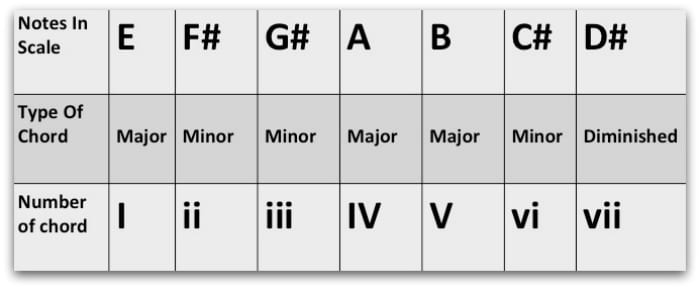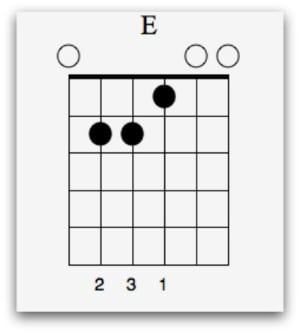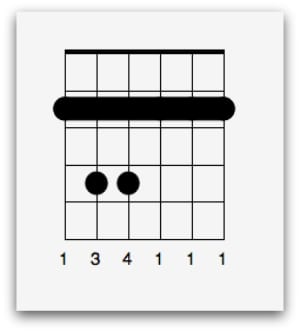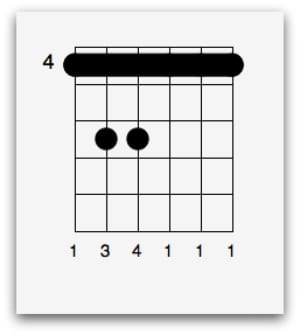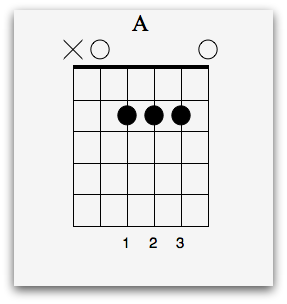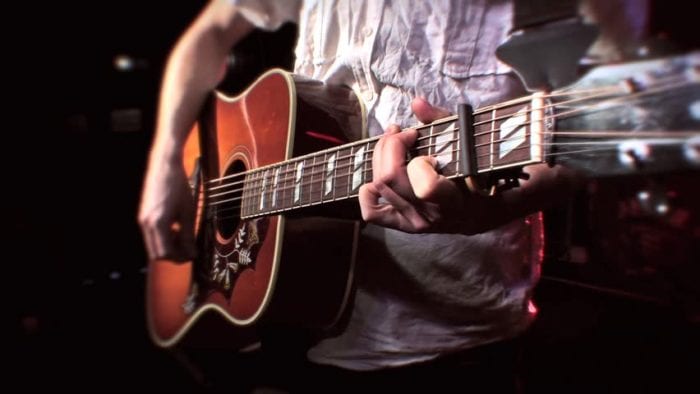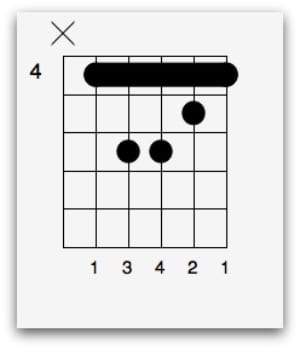Wondering what the chords in the key of E are? This article will help you learn them and understand them. Let’s dive in!
In this free guitar lesson you will learn:
- How the key of E is constructed (and what it is)
- Major Scale theory (this is not as scary as it sounds and VERY useful!)
- All of the chords in the key of E
Over 100,000 guitar-learners get our world-class guitar tips & tutorials sent straight to their inbox:
Click here to join them
Get our best guitar tips & videos
Chords in the key of E
There are loads of different keys in music, but we’re just going to focus on the key of E here. This is the guitar’s ‘native’ key and that’s why these chords are so useful to know and understand.
All keys are built from scales and the key of E (or to use its full name, ‘E major’) is constructed from, you guessed it, the scale of E major.
The E major scale dictates what the chords in the key of E are.
So to understand the chords in the key of E major, we have to start with the scale of E major.
The E major scale
The notes in the E major scale are as follows: E F# G# A B C# D#
In tab form it looks like this:
Note that in the example above we go through 2 full octaves (so we see the notes listed above appear twice).
And it sounds like this:
.
So if you play these notes on your guitar, you would be playing in the key of E Major.
If you want to understand notes better, read this article of ours: Guitar Notes Explained: A Guide For Beginners
Understanding this key (or any key)
The chords in a key are dictated by the notes of its scale.
I’ll write that again because it’s the absolute heart of this lesson! The chords in a key are dictated by the notes of its scale.
- The chords in the key of E major are dictated by the notes in the scale of E major.
- The chords in the key of D minor are dictated by the notes in the scale of D minor.
- And so on….
From each note within the scale we can build a chord.
But there are rules that dictate what type of chord a note will become (major, minor or diminished).
Learn 12 EASY beginner chords with our popular guide


Where should we send it?
✅ Stop struggling. Start making music.
✅ Learn beginner-friendly versions of every chord.
This is our most popular guide and it will improve your chord ability quickly! 😎
Get your own personalised guitar-learning plan 🎸
Get a custom guitar-learning plan here: Click here for GuitarMetrics™
World-Class Guitar Courses 🌎
Learn from the world's best guitar educators: Click here for our guitar courses
How to work out the chords in any key
Each note in a scale has a number. (For example, E is the 1st note in the scale of E major. Therefore it is number 1.)
Each number relates to a chord.
The number 1 note is always a major chord. (So in this instance the chords would be E major.)
The number 2 note is always minor. (In this instance the chord would therefore be F# Minor. Because F# is the second note in the E major scale.)
- For E, A and B we have major chords, these tend to have a brighter, happier sound.
- For the F#, G# and C# we have minor chords, these chords tend to have sadder sound.
- And for D# we have a diminished chord, this chord has a lot of tension and has quite a bitter sound. (Diminished chords are hardly used at all in popular music.)
Notice that the numbers we mentioned before have now become roman numerals now. I have no idea why this is the case, but this is just how the different numbers of a scale are commonly written in the musical world.
These roman numerals are often referred to as the ‘degrees of a scale’. (So, using the table above you can see that the ‘5th degree’ in the scale of E major is B.)
The coolest thing about understanding how chords relate to the notes of the scale, is that when you apply this to other major scales the chord formula stays the same.
Like so many things in the guitar world, this concept is moveable.
The pattern of notes becoming chords always goes like this:
- Major
- Minor
- Minor
- Major
- Major
- Minor
- Diminished
Just forget the diminished chord for now because it’s so niche.
As you can see, there are 3 major chords in a key and 3 minor chords in a key.
- The 1st, 4th and 5th notes become major chords.
- The 2nd, 3rd and 6th notes become minor chords.
Knowing what we now know, let’s move on and look specifically at the key of E.
Download our lead guitar cheat-sheet to make things easier
It's hard to understand which scales work with which keys.
So we created a cheat-sheet! A key and scale-finder that you can use again and again.
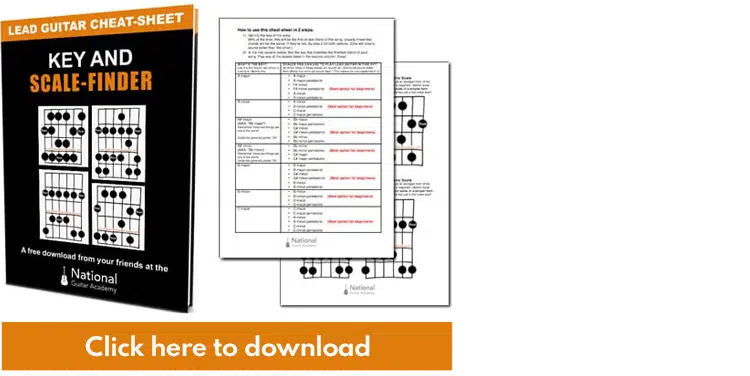
Get your personalised guitar-learning plan 🎸
Get a custom guitar-learning plan here: Click here for GuitarMetrics™
World-Class Guitar Courses 🌎
Learn from the world's best guitar educators: Click here for our guitar courses
How To Play E Major
To play this chord you:
- Place your second finger on the second fret of the A string.
- Place your third finger on the second fret of the D string.
- Place your first finger on the first fret of the G string.
- Strum all the strings.
There are loads of different ways to play an E major chord, check out this article to learn more: 4 Easy Ways To Play The E Chord On Guitar
Chords In The Key Of E – F# Minor
There are a few different ways to play this chord, we’re going to be focusing on the barre version.
Barre chords can be tricky, so if you’re a little stuck on how to play barre chords, this lesson may be useful for you: 3 Tips For Clean & Easy Barre Chords
To play F# Minor you:
- Place your first finger on the second fret on the low E string, whilst barring over on the G, B and high E string.
- Place your third finger on the fourth fret of the A string.
- Place your fourth finger on the fourth fret of the D string.
.
Chords In The Key Of E – G# Minor
For G# Minor we’re going to use the same shape as F# Minor, but instead of the root starting on the second fret of the low E string, we’re going to start on the fourth fret of the low E string instead.
So this means that we simply move the same shape up two frets to get to the fourth fret.
Not sure how to read this chord box? Check out this article to learn more about chord boxes: How To Read Guitar Chordboxes
To play the G# Minor Chord you:
- Place your first finger on the fourth fret of the low E string, whilst barring over on the G, B and high E string.
- Place your third finger on the sixth fret of the A string.
- Place your fourth finger on the sixth fret of the D string.
.
Want free guitar tips and video lessons delivered to your inbox?
Join over 100,000 guitar learners and subscribe to our guitar-tips-by-email service. (It's free.)
We'll send you a series of lessons that will move you to the next level of your guitar journey.
Learn how everything fits together quickly, easily and effectively. We share ninja tips (for instant fun!) but also timeless fundamentals that will deepen your understanding.


Get our best guitar tips & videos
Our Guitar Courses
To become a better guitarist click here to see our guitar courses
Get your personalised guitar-learning plan 🎸
Want us to make a guitar-learning plan that is customised to you? Click here for GuitarMetrics™
Chords In The Key Of E – A Major
There are many different variations of the A major chord, we’re going to use a standard open string version.
To play this chord you:
- Place your first finger on the second fret of the D string.
- Place your second finger on the second fret of the G string.
- Place your third finger on the second fret of the B string.
- Strum from the A string.
.
There are loads of ways to play the A chord, here’s an article which explains some! 3 Easy Ways To Play The A Chord On Guitar
Chords In The Key Of E – B Major
There are loads of different ways to play the B Major Chord, however we’re going to play with our root starting on the A string.
To play a B Major Chord you:
- Place your first finger on the second fret of the A string, whilst barring over the high E string.
- Place your second finger on fourth fret of the D string.
- Place your third finger on the fourth fret of the G string.
- Place your fourth finger on the fourth fret of the B string.
- Strum from the A string.
.
This chord can be very tricky, check out this article to make sure you have it down! B Guitar Chord: 4 Essential Tips & Tricks You Need To Know
Chords In The Key Of E – C# Minor
C# is the sixth note in the scale, so this is our sixth chord. This is a great chord and an essential to know when learning the chords in the key of E.
Here’s how to play it.
- Place your first finger on the fourth fret of the A string.
- Place your third finger on the sixth fret of the D string.
- Place your fourth finger on the sixth fret of the G string.
- Place your second finger on the fifth fret of the B string.
- Strum from the A string!
.
Naturally the barre chords we have covered in this article are a lot harder than your standard chords, however if you can crack them you will learn SO much about guitar, and have a completely new world to explore.
Chords In The Key Of E – D# Diminished
This is the final chord in the key of E. Even though it isn’t used very often, it can be really useful to know.
This chord has a lot of tension, so if you decide to use it in a song, use it sparingly!
How To Play D# Diminished
We’re going to be playing this chord with our root note on the A string.
- Place your first finger on the sixth fret of the A string.
- Place your second finger on the seventh fret of the D string.
- Place your third finger on the seventh fret of the B string.
- Strum from the A string.
.
What Type of Guitarist Are You?
Take our 60-second quiz & get your results: Take The Quiz
Join the world's best online guitar school 🌎
- Get your own personalised guitar learning plan (customised just for YOU).
- World-class online guitar courses. Learn at your own pace.
- Community Campus & Learning Forum - A friendly community! Connect with our team & students. 😊
- Beginner Song library with chordsheets, tabs and tips. (Songs suitable for all levels!)
- Regular live streams, seminars and Q&A sessions - Learn from world-class guitar educators. Get all your questions answered!
Click here to learn more about National Guitar Academy membership 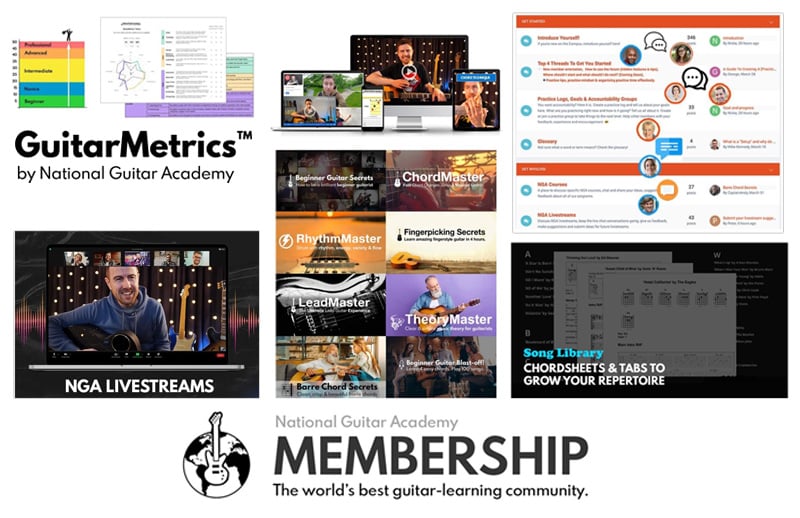
Cool Guitar T-shirts 😎
Look cooler! Check out our merch: Click here to see our merch store
Want free guitar tips and video lessons delivered to your inbox?
Join over 100,000 guitar-learners and subscribe to our guitar-tips-by-email service. (It's free.)
We'll send you a series of lessons that will move you to the next level of your guitar journey.
Learn how everything fits together quickly, easily and effectively. We share ninja tips (for instant fun!) but also timeless fundamentals that will deepen your understanding.


Get our best guitar tips & videos
Popular Lessons
How To Learn Guitar: An 11-Step Programme For Beginners
How To Choose The Perfect Beginner Guitar
More Cool Guitar Stuff
Learn about National Guitar Academy: About Us
Join us on Facebook for daily guitar tips.
Listen to our Learn Guitar Podcast for rapid guitar progress.
Check out our free chord lessons.



